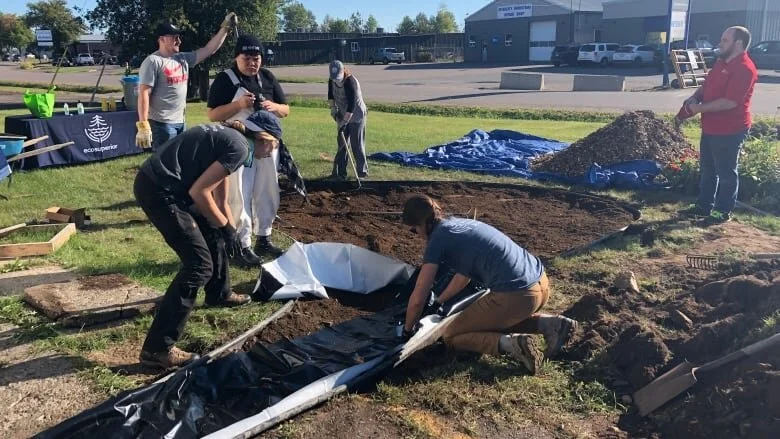Researchers from northern Ontario are in Peru where they are sharing their knowledge of what has become known as the "Sudbury method." The Sudbury method refers to the community's work over decades to rehabilitate a landscape damaged by mining and smelting. "Sudbury has become recognized almost globally now for taking one of the most damaged landscapes on planet Earth and through a lot of work by citizens, community members, industry and government, turning it into actually a really, really nice place to live," said Graeme Spiers, an emeritus professor in environmental and earth sciences at Laurentian University.
With a canoe ride down the Grand River in Ontario, these paddlers bring a 400-year-old treaty to life
For 10 days every summer, a group of Indigenous and non-Indigenous people launch their canoes each morning after a Haudenosaunee Thanksgiving Address and continue on their journey down the Grand River in southern Ontario. The annual Two Row on the Grand is not just any paddling trip — it's an enactment of the Two Row Wampum treaty, an agreement made more than 400 years ago between the Haudenosaunee people and Dutch settlers.
Brown and Caldwell names Dave Bergdolt as western Canadian leader
There’s a new leader at Brown and Caldwell. Vice-president Dave Bergdolt has been promoted to Western Canada area leader, according to a news release. Bergdolt brings three decades of water and wastewater infrastructure and treatment expertise to the position, which will be “key in helping the region overcome environmental and water-related challenges,” reads the release. He started with Caldwell about 15 years ago and has overseen numerous projects including wastewater facility expansions, water quality improvements and sewer system rehabilitation.
EcoSuperior rain garden in Thunder Bay to help reduce water flowing to city storm sewer
The front lawn at Habitat for Humanity in Thunder Bay, Ont., is smaller thanks to the work of some volunteers, to build a new rain garden. The garden, measuring about four metres by three metres, will help absorb water running off of the roof of the group's office and ReStore in the city. The rain garden was created with the work of volunteers on Wednesday morning. "It's one of many different techniques that you can use in an urban watershed to manage storm water runoff," said Julia Prinselaar, a program coordinator with EcoSuperior.
Alumna-led venture amplifies voices of Indigenous water treatment operators
When Bita Malekian, BSc (Eng)’18, MEng’21, received her bachelor’s degree from the Schulich School of Engineering, she was inspired by the call to action to, as she says, “use the skills and knowledge I learned to give back to my community.” Since then, Malekian has launched Water Movement (WM), a venture supported by the Calgary Professional Chapter of Engineers Without Borders. The initiative provides a formal platform for Indigenous water treatment operators across Canada to connect, ask questions and access a video library that features tutorials on a wide variety of topics, from managing treatment plants to tips on testing chlorine residue in water.
Arctic Ocean was once a tub of fresh water covered with a half-mile of ice
The Arctic Ocean was once a pool of fresh water capped with an ice shelf half as thick as the Grand Canyon is deep. If that's hard to envision, don't despair. Scientists were surprised at the discovery, published Wednesday (Feb. 3) in the journal Nature, as well. The trick to envisioning this odd arrangement is to think about the relationship between ice sheets and the ocean. When ice sheets melt, they dump water into the ocean, raising the sea level. But when ice sheets grow, as they have during Earth's glacial periods, sea level drops.
‘Water is life’ teaches new Syilx children’s book series
A new children’s book series by a Syilx and Nlaka’pamux author is teaching kids about the importance of water as a living entity and how to protect it. “It was significant and important for me to write this series because water is life. I wanted to create awareness of water practices and policies, to ensure that it’s protected,” says author Harron Hall. The four-book series, titled Follow the Water, will launch on Feb. 5, and marks Harron’s publishing debut.
Longstanding climate change research project continues in Old Crow, Yukon
Vuntut Gwitchin traditional territory is one of the fastest warming areas in the world. That's why the Vuntut Gwitchin Government is teaming up with researchers from across Canada to address community concerns about climate change and its impacts on the land around Old Crow, Yukon. "The consequences of that are going to be long ranging and diverse and they're going to touch on every aspect of the environment," said Jeremy Brammer, fish and wildlife manager for the Vuntut Gwitchin Government.









